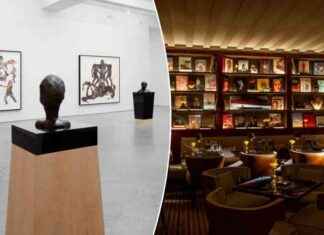The Romanian writer Mircea Cartaresciu is the first favorite of betting houses two days before the delivery of the Nobel Prizes of Literature, which will be announced on Thursday, in Stockholm, at 1:00 p.m.
The Solenoid author appears next to his Japanese colleague Haruki Murakami among the most likely laureates.
Among the 10 favorites, four and nine women, novelists appear.
Last year, an American poet, Louise Glück, received the prize.
Next to them, the list of favorites includes Chinese, Norwegians, French, Hungarians … and a Spanish, Javier Marías, placed in a remarkable seventh place.
Romania, 1956. Novelist and poet.
The narrative books of Him are variations of itself an expressionist, obsessive and very poetic chronicle of the Kafkian period of socialist totalitarianism in their country.
A book: ‘solenoid’
To know more.
Japan, 1949, novelist.
He mixed the keys to sentimentality and pop culture with Japan’s literacy: Jazz, Beatles, lightness, deammer …
A book: ‘Tokyo Blues’.
To know more.
Russia, 1943. Novelist.
Before novelist he was a film scriptwriter.
The texts of him are retatos of post-Afoviet Russia, charged with psychology, in the style of the classics of their country.
A book: ‘Sonietchka’
To know more.
Canada, 1950. Poet, narrator and essayist.
From the academic activity of it, she has taken the tradition of classical mythology and adapted to the contemporary world.
A book: ‘Red autobiography’
To know more.
Kenya, 1938. Novelist and essayist.
He is the great chronicler of the political emancipation of Africa.
He began his career writing in English but left him by his native tongue, the Gykuyu,
A book: “A grain of wheat ‘
To know more.
France, 1940. Novelist.
Almost minimalist narrator of the experience of the working class and women in the country of it during the (apparently) glorious 30.
A book: ‘The Years’
To know more.
Canada, 1939. Novelist and poet.
He began his career in the ashes of the counterculture with novels of disenchantment and independence.
The tale of her maid became a world celebrity.
A book: ‘The blind murderer’
To know more.
Guadalupe, 1937. Novelist.
The novels of him recattate the oral history of African communities in the Caribbean.
In addition, he has several memoir books that narrate the years of decolonization.
A book: ‘Segu’
To know more.
Hungary, 1956. Novelist.
He author of complex novels, between distopy, the Kafkian nightmare and philosophical reflection, which portray the decline of his country in the twentieth century.
A book: ” Satanic Tango ‘
To know more
Hungary, 1942. Novelist.
Old photojournalist refugee in literature after the Soviet invasion of his country.
Nadas is also a link with the great psychological novel of the twentieth century.
A book: ‘The book of memory’
To know more
Ancient and Barbuda, 1949. Narrar.
She perpetrator of brief novels of almost poetic writing that explore in mothers and daughters, exile and decolonization.
A book: ‘A small place’
United States, 1936. Novelist.
The great rapporteur of the confusion of the end of the twentieth century appeared as a continuator of the work of Thomas Pynchon obscured by the language of advertising and means.
A book: ‘white noise’
To know more.
United States, 1938. Novelist.
It prolific author, writer of histories often brief, urban, furious and full of references to juvenile culture, at the height of the great realistic novel of her country.
A book: ‘Blonde’
To know more.
China, 1953. Narrar.
Daughter of a dissident family, the brief texts of her also contradict the realistic literary tradition of her country through speculative fiction.
‘Border’
To know more.
United States, 1937. Novelist.
The great worship writer of the generation of him: fleezed, partly, psychedelic and chaotic … The books of him are the saturating and caustic portrait of the counterculture of the twentieth century.
A book: ‘The rainbow of gravity’
To know more.
Norway, 1959. Theatrical writer.
Author of very poetic pieces, often experimental, in which the characters are taken up to the limit while receiving a compassionate look.
A book: ‘Trilogy’
Spain, 1952. Novelist.
Very classical narrator of cosmopolitan and sophisticated stories that illustrate the entrance of Spain in democracy and in European normality.
A book: ‘All Souls’
To know more.
France, 1958, novelist.
The stories of him appear to be amoral essays of the contemporary world, from sexuality to inequality, but they hide tistísima stories of loneliness.
A book: ‘Expansion of the battlefield’.
To know more.
China, 1958. Novelist.
The novels of him have collected the tearing of Mao’s years and the survival of feudal structures in communist China.
A book: ‘The Kisses of Lenin’
To know more.
Serbia, 1938, poet.
The first part of him is marked by a minimalist sense of language.
Then, after arriving in the United States, Simic is left by the chaos of real life.
A book: ‘The world does not end’
To know more.
Ireland, 1930. Novelist.
The first books of it meant a liberal and feminist revulsive for their country equivalent to that of nothing in Spain.
A book: ‘Field Girls’
To know more.
Norway, 1968. Narrator.
The 3,500 pages of ‘my struggle’, the series of six memo books, were the great literary issue of the last decade: wound souls, intense stories, bursts of violence and sweetness, self-absorption and modern quixotism ….
A book: ‘My fight’
To know more.






